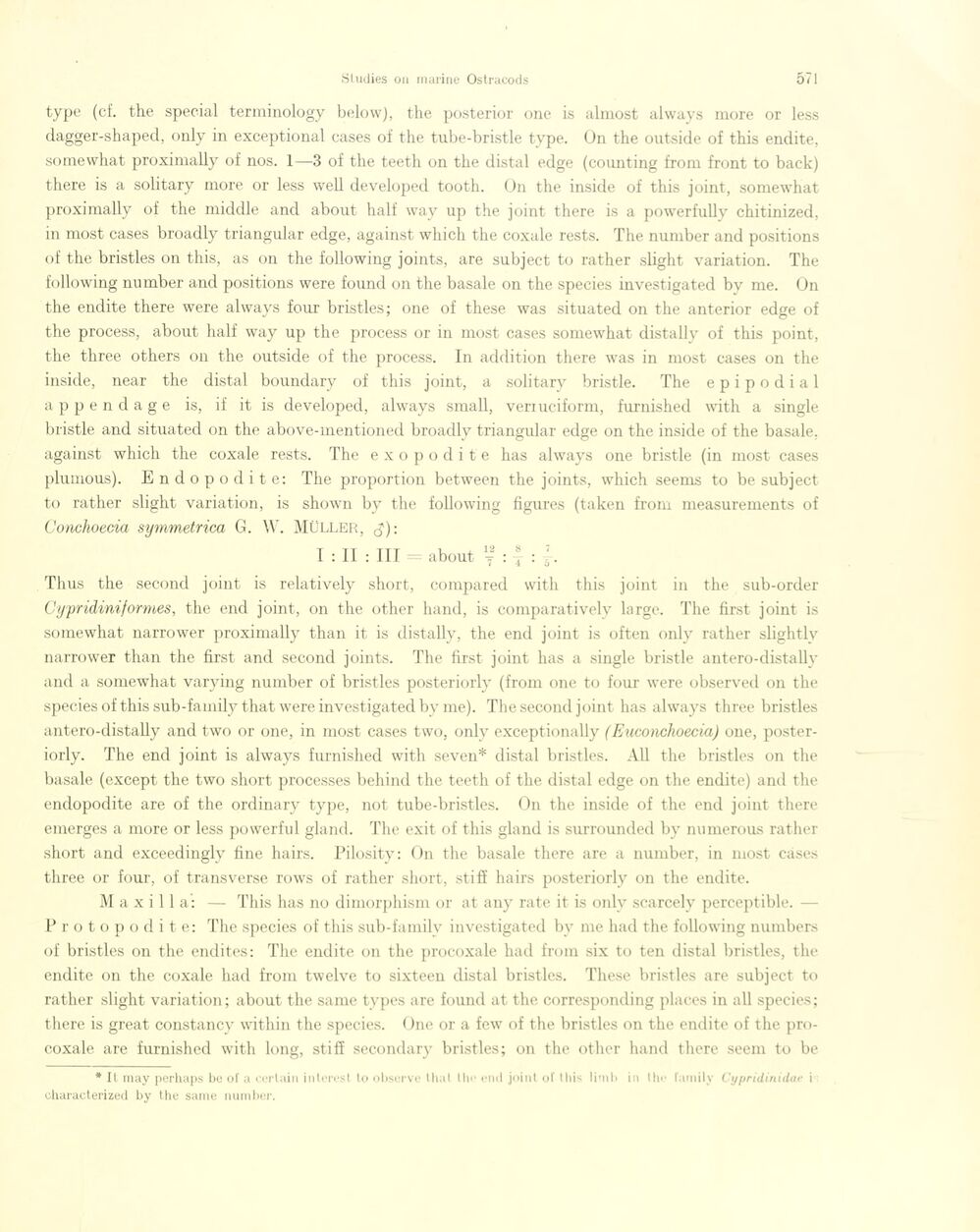
Full resolution (JPEG) - On this page / på denna sida - Sidor ...

<< prev. page << föreg. sida << >> nästa sida >> next page >>
Below is the raw OCR text
from the above scanned image.
Do you see an error? Proofread the page now!
Här nedan syns maskintolkade texten från faksimilbilden ovan.
Ser du något fel? Korrekturläs sidan nu!
This page has never been proofread. / Denna sida har aldrig korrekturlästs.
type (cf. the special terminology below), the posterior one is almost always more or less
dagger-shaped, only in exceptional cases of the tube-bristle type. On the ontside of this endite,
somewhat proximally of nos. 1—3 of the teeth on the distal edge (counting from front to back)
there is a solitary more or less well developed tooth. On the inside of this joint, somewhat
proximally of the middle and about half way up the joint there is a powerfully chitinized,
in most cases broadly triangulär edge, against whicli the coxale rests. The number and positions
of the bristles on this, as on the following joints, are subject to rather slight variation. The
following number and positions were found on the basale on the species investigated by me. On
the endite there were alwavs four bristles; one of these was situated on the anterior edge of
the process, about half way up the process or in most cases somewhat distallv of this point,
the three others on the outside of the process. In addition there was in most cases on the
inside, near the distal boundary of this joint, a solitarv bristle. The e p i p o d i a 1
appendage is, if it is developed, always small, veriuciform, furnished with a single
bristle and situated on the above-mentioned broadly triangulär edge on the inside of the basale,
against which the coxale rests. The exopodite has always one bristle (in most cases
plumous). Endopodite: The proportion between the joints, which seems to be subject
to rather slight variation, is shown by the following figures (taken from measurements of
Conchoecia symmetrica G. W. MÜLLER, tf) :
I : II : III ■-= about j
Thus the second joint is relatively short, compared with this joint in the sub-order
Cypridiniformes, the end joint, on the other hånd, is comparatively large. The first joint is
somewhat narrower proximally than it is distally, the end joint is often only rather slightlv
narrower than the first and second joints. The first joint has a single bristle antero-distally
and a somewhat varying number of bristles posteriorly (from one to fom- were observed on the
species of this sub-family that were investigated by me). Thesecond joint has always three bristles
antero-distally and two or one, in most cases two, only exceptionally (Exiconchoecia) one,
posteriorly. The end joint is always furnished with seven* distal bristles. All the bristles on the
basale (except the two short processes behind the teeth of the distal edge on the endite) and the
endopodite are of the ordinary type, not tube-bristles. On the inside of the end joint there
emerges a more or less powerful giand. The exit of this giand is surrounded by numerous rather
short and exceedingly fine hairs. Pilosity: On the basale there are a number, in most cases
three or four, of transverse rows of rather short, stifi hairs posteriorly on the endite.
Maxilla: — This has no dimorphism or at any rate it is only scarcelv perceptible.
-Protopodite: The species of this sub-familv investigated bv me had the following numbers
of bristles on the endites: The endite on the procoxale had from six to ten distal bristles, the
endite on the coxale had from twelve to sixteen distal bristles. These bristles are subject to
rather slight variation; about the same types are found at the corresponding places in all species;
there is great constancy within the species. One or a few of the bristles on the endite of the
procoxale are furnished with long, stifi secondary bristles; on the other hånd there seem to be
* It may perhaps bo of a certain in teros t to observe that the em! joint of I tiis limb in the family Cypridinidae i
characterized by the same number.
<< prev. page << föreg. sida << >> nästa sida >> next page >>